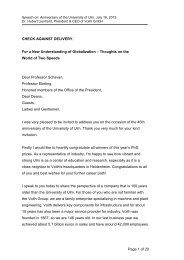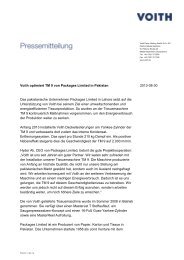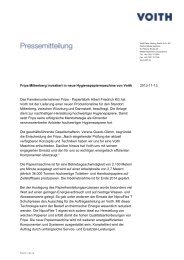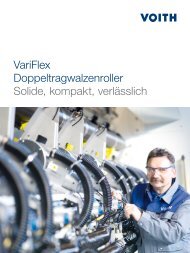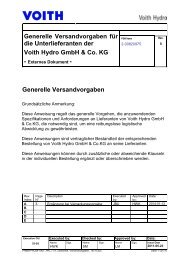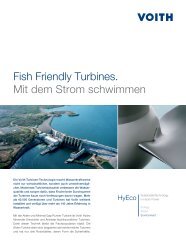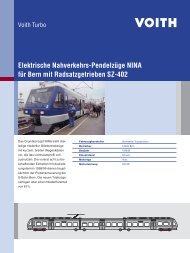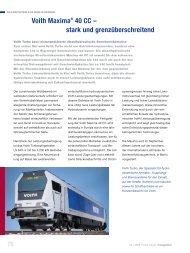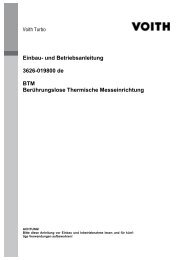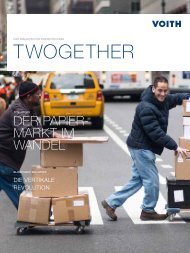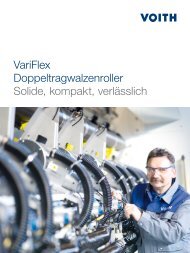2 Water for life requires inventiveness I Daio Paper Mishima ... - Voith
2 Water for life requires inventiveness I Daio Paper Mishima ... - Voith
2 Water for life requires inventiveness I Daio Paper Mishima ... - Voith
Create successful ePaper yourself
Turn your PDF publications into a flip-book with our unique Google optimized e-Paper software.
PRoDUCTs<br />
pleted its last series of test runs successfully.<br />
Now the papermakers had<br />
the final proof that high grade premium<br />
products <strong>for</strong> the tissue market<br />
could be produced at lower cost, with<br />
considerably less consumption of energy<br />
resulting in lower cost and less<br />
environmental impact. The Atmos<br />
process developed by <strong>Voith</strong> <strong>Paper</strong><br />
Sao Paulo research engineers lives<br />
up to its name – Greek <strong>for</strong> vapour –<br />
by breathing fresh air into the tissue<br />
production market. Furthermore, <strong>for</strong><br />
the first time in almost 30 years, an<br />
innovative process has been matured<br />
to open up a new epoch in the production<br />
of soft lightweight tissue.<br />
Tissue papers have quite different<br />
characteristics to those of other<br />
grades. <strong>Paper</strong> towels have to be absorbent<br />
while at the same time strong<br />
enough not to tear when wet. Toilet<br />
paper must be soft, and paper handkerchiefs<br />
have to be even softer to<br />
protect the sensitive facial skin.<br />
These requirements can only be met<br />
if the tissue has enough bulk but is<br />
still thin, airy and porous. With basis<br />
weights of only 10 to 40 g/m2 , tissue<br />
papers are the lightest grades of all.<br />
But manufacturing such soft and airy<br />
grades is certainly not easy.<br />
Flat pressed sheets instead of<br />
airy tissue<br />
Airiness and softness is destroyed<br />
above all by papermaking processes<br />
that press water out of the paper<br />
web. The originally voluminous and<br />
airy fiber mixture is compressed thereby<br />
– often at 30 bar or more – into a<br />
flat sheet of paper that is neither absorbent<br />
nor really soft. Although this<br />
kind of paper is creped as it comes<br />
off the Yankee cylinder to seem more<br />
voluminous, its characteristics are not<br />
changed at all. To improve tissue pa-<br />
Atmos test runs successfully completed. Beaming faces surround the tissue machine in<br />
the Talagante mill in Chile.<br />
per quality, a process known as<br />
Through Air Drying (TAD) was developed<br />
about 30 years ago whereby hot<br />
dry air at more than 350 °C is blown<br />
through the tissue web and structured<br />
fabric on a large additional drum in the<br />
tissue machine. Since however hot air<br />
alone does not make the tissue soft<br />
enough, the paper is first sucked on to<br />
a structured fabric while still wet. This<br />
imparts it with 3-dimensional structure<br />
be<strong>for</strong>e being dried in hot air. Pressing<br />
is largely avoided thereby, so that the<br />
paper remains soft and airy. Above all<br />
the absorptive capacity of TAD tissue<br />
was much higher than ever achieved<br />
previously: paper towels made of this<br />
tissue were able to absorb fifteen<br />
times their own weight in water, twice<br />
as much as conventionally produced<br />
tissue.<br />
Although TAD technology has been<br />
continuously improved since then,<br />
energy cost rises above all in recent<br />
times have made it too expensive.<br />
As a result, tissue mills using TAD<br />
machines are faced with shrinking<br />
profitability. For this and other<br />
reasons, <strong>Voith</strong> already decided some<br />
years ago not to manufacture TAD<br />
tissue machines. Instead, the <strong>Voith</strong><br />
<strong>Paper</strong> São Paulo development engineers<br />
followed another path. Their<br />
goal was to produce high quality<br />
tissue with much less energy and<br />
fiber usage. Together with their <strong>Voith</strong><br />
<strong>Paper</strong> Fabrics colleagues, they finally<br />
reached this goal with the Atmos<br />
process.<br />
54 26 I 2008 I <strong>Voith</strong> <strong>Paper</strong> I twogether





